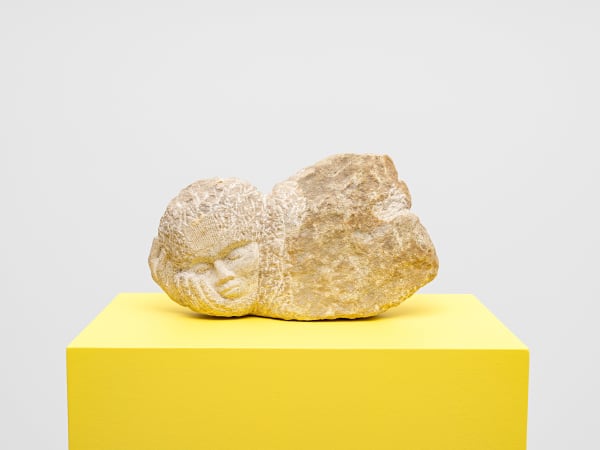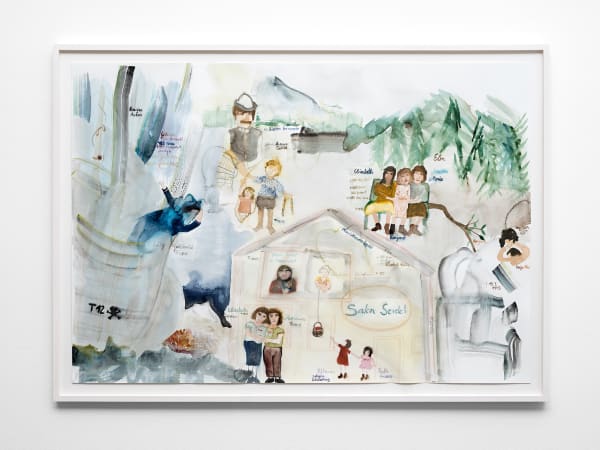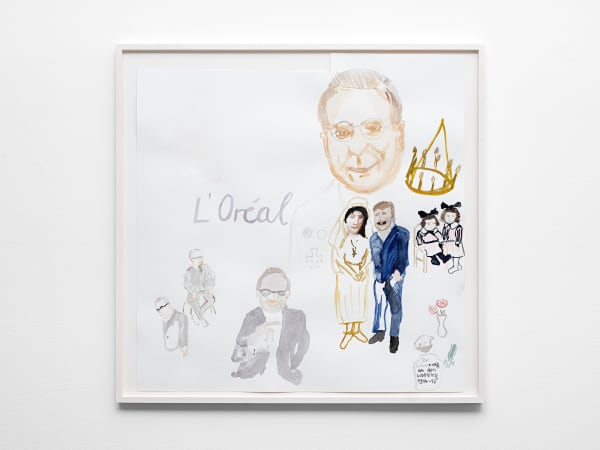MICHAELA MEISE: "Line Mercator"
STANDARD (OSLO)
PRESS RELEASE
-----
MICHAELA MEISE
"LINE MERCATOR"
24.06.2022-23.07.2022 / PREVIEW: FRIDAY 24.06.2022 / 19.00-21.00
-----
STANDARD (OSLO) is proud to present a solo exhibition of the Berlin-based artist Michaela Meise. Entitled, "Line Mercator", the exhibition brings together four framed watercolour paintings and three sculptures, which are juxtaposing an extensive research of the artist's family tree with a far more intuitive approach in terms of sculpting from limestone.
I.)
These watercolor paintings came into being last year while I started taking an interest in researching my family tree. I found birth and death certificates on ancestry.com, a popular genealogy website, revealing professions, interconnections and addresses in Hanau for over 100 years. Many ancestors were born and died in the house where my grandparents later had a hair salon. It appealed to me to find more artisans in the family, having been goldsmiths and linen merchants. Starting with my great-great-grandfather Franz Müller - who learned the trade of making linen in a Hessian villlage before moving to Hanau - who was born an illegitimate son and inspired the title to this exhibition. His profession "line mercator" is mentioned in the church books of his village, written in Latin.
II.)
During the process of drawing the maternal and paternal family tree, my parents' position in the pictures maintained that of being children. Going further back in time meant crossing the time line of 1945, and addressing the lives of my ancestors during the time of German Fascism and World War II. I had knowledge of my grandparents' and grand- grandparents' political opinions and personalities. They were very much in line with the political consensus of any given time and current government, whether during the years before or after World War II. For example, during the years of Fascism, Heini Seidler - the great-grandfather on the maternal side of the family and indeed the first of many hairdressers of the family - appeared to please many clients. He never quit his Jewish customers, but still chose to join the National Socialist Party. Thereafter, during the years of postwar Germany, he was active in the hair dressers guild and as a local politician of the Christian Democratic Party. In fact, the only person that publicly displayed a stance against Fascism was my paternal grand-grandfather. He was a clergyman with ties to the resistance movement of the Protestant church. His son in law, a devoted protestant himself, nonetheless ended up serving in the Wehrmacht from 1940 to 1945 and died in combat.
III.)
During a cleanup last year we found letters he wrote to his wife during World War II. My dad possessed his father's letters in a box all the time, but had forgotten or neglected them. Written in Sütterlin handwriting, I had difficulties deciphering them so my dad read the letters out. It became clear that his parents had written each other every week of World War II. The letters' content will be my future inquiry. During the first inspection, we were able to understand where he had been based as a soldier - initially in France in 1940, then again in 1943, before later writing from a Polish city. But after a specific time in 1944 all letters were located as "in the East" - a troublesome nationalist term for occupied territory in Eastern Europe. In the box with letters were also postwar correspondences of my grandmother with the Red Cross and other institutions, even with a psychic medium. Margarete Meise searched desperately for her missing husband and never married again. She lived with three children at her parents' rectory.
IV.)
The last watercolor locates its motifs from my grandfather Willi's photo album. These are photos that he took during his training in the navy and during the first year of World War II. As a soldier in the navy, he served on a torpedo boat that took part in the invasion of Norway in 1940. His photos are not corresponding with the historical events. They show comrades celebrating Christmas, a little dog living on the torpedo boat and photos of soldiers walking in the hillsides of Bergen. It is not clear what they are doing - if it is a moment of leisure or if those soldiers tromping across the scenery are on an operation. In any case they don't belong there.
-----
V.)
I think I recognize the hillside from that painting. Having grown up in Bergen, the reminders of World War II was constant with the continous presence of grey concrete structures - foxholes, bunkers and concrete foundations for canons - perforating the hillsides and facing the North Sea. We used to play in and around them, sometimes playing war and other times thinking we could make use of them that had them disconnected from their purpose and disconnected from the reality of war. I think that these soldiers in the painting are walking down to Sandviksfjellet from Rundemannen. Every weekend, people will hike these mountains, but with each year having less knowledge as to what these grey concrete structures are or how they made it there. They merely end up as interruptions of the landscape.
-----
Michaela Meise (born 1976, Hanau, Germany) received her education from Städelschule, Frankfurt am Main and Kunsthochschule Kassel. This is her fourth solo exhibition at STANDARD (OSLO). Other recent solo exhibitions include KM Galerie, Berlin; Städtische Galerie Nordhorn, Nordhorn; Koenig Galerie, Berlin; dependance, Brussels; and Richard Telles Fine Art, Los Angeles. Other recent group exhibitions include "Die Zukunft der SPD", curated by Hans-Jürgen Hafner & Gunter Reski, Galerie Zwinger, Berlin; "Nico: Wie kann die Luft so schwer sein an einem Tag an dem der Himmel so blau ist", Institut für Moderne Kunst, Nürnberg; "Hand seiner Zeit", KM, Berlin; "Global National", curated by Raimar Stange, Haus am Lützowplatz, Berlin; "The Summer Vocation of a Teenage Bee", curated by Audrius Pocius & Nicholas Matranga, Contemporary Art Centre, Vilnius; "Verstrickungen/Entanglements", after the butcher, Berlin; "SOS Brutalismus, cur. by Oliver Elser, Deutsches Architekturmuseum, Frankfurt a.M.; "Face Tunes", curated by Thomas Thiel, Bielefelder Kunstverein, Bielefeld; and "Kafka", curated by Raimar Stange, Reisebüro Global, Berlin. Meise lives and works in Berlin.
-----
Installation photography: Vegard Kleven








